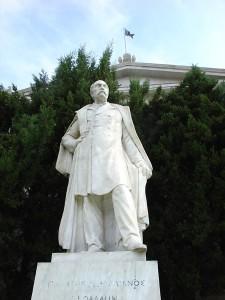Kefalonia History
Interesting to note is that Lord Byron lived on the island at the time of the Greek War of Independence, and there he wrote his famous “Don Juan.”

Kefalonia has had a very interesting history. Finds on the island date to the presence of man during the Paleolithic period; then, during the following Neolithic period and subsequently to the Mycenaean period, during which time the island prospered and began trading with its near neighbors, extending as far as the Cyclades. In 1500 B.C. trade came to a halt and little is known of the island for several centuries. It is presumed that the devastating eruption of the Santorini volcano destroyed much of the island, as well as its commercial fleet. During the 11th Century, B.C. and until the 5th Century B.C., the island suffered a series of rulers, from Dorian, to Corinthian, to Euboeans. During antiquity, the capital of the island was the port of Sami. During the 5th Century, B.C., four main towns of the island, including Sami, joined together to form a league for security purposes, though each town retained its autonomy and even had its own currency. This lasted until the Peloponnesian War, when the towns disagreed as to whom to support.
In 187 B.C., the Romans came to occupy the island and held it until 395 A.D. It then became part of the Byzantium Empire until 1185, when the Venetians took control. They built an impressive castle east of the present capital of Argostoli, and made it the new capital of the island. They held the island until 1483 when the Turks struck and destroyed a great deal of the island. The Venetians regained control in 1500, only to lose it in 1797 to the French. During this period, an earthquake struck the island and destroyed a great deal of the castle. The capital was then transferred to Argostoli, where it still remains today. Following the brief occupation by the French, there ensued further occupations of brevity, including that of the Russians, Turks again, then finally the British in 1809. They retained their rule until Kefalonia united with Greece in 1864. Interesting to note is that Lord Byron lived on the island at the time of the War of Independence, and there he wrote his famous “Don Juan.”
A very interesting chapter in Kefalonia's history is about to be added soon. A series of facts have made researchers doubtful whether nowadays Ithaka is Ulysse's island Ithaca, during the Trojan War Era. They are working on a project to establish Mr Bittlestone's hypothesis that Ithaca was a different island, much closer to Kefalonia. That island, according to Professor Underhill, is today part of Kefalonia, namely the Paliki Peninsula! By studying rocks and sediment in the valley that lies between Paliki and the rest of Kefalonia, Professor Underhill set out to test the hypothesis that the peninsula used to be an island, perhaps the Homeric Ithaca. The rocks filling up the gap are considered to be of so-called drift cover nature, and if the same kind of sediments are found in much deeper layers, the hypothesis should be reconsidered. The findings so far have been characterized as "unexpected and thought provoking".
(Above, photo of one of the most famous Kefalenians, Vallianos, founder of the Greek National Library in Athens) |
|



